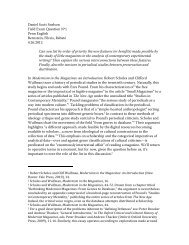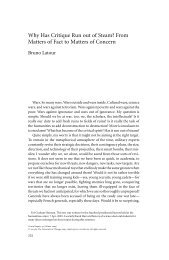Bruno Latour, Aramis, or the Love of Technology, PDF - Dss-edit.com
Bruno Latour, Aramis, or the Love of Technology, PDF - Dss-edit.com
Bruno Latour, Aramis, or the Love of Technology, PDF - Dss-edit.com
Create successful ePaper yourself
Turn your PDF publications into a flip-book with our unique Google optimized e-Paper software.
f<strong>or</strong> very primitive, basic gestures like <strong>the</strong> ones Leroi-Gourhan calls "technological trends."This rejection <strong>of</strong> Platonism gives greater freedom to <strong>the</strong> observer <strong>of</strong>machines than to <strong>the</strong> observer <strong>of</strong> facts. The big problems <strong>of</strong> realism andrelativism do not bo<strong>the</strong>r him. He is free to study engineers who are creatingfictions, since fiction, <strong>the</strong> projection <strong>of</strong> a state <strong>of</strong> technology from five <strong>or</strong>fifty years in <strong>the</strong> future to a time T, is part <strong>of</strong> <strong>the</strong>ir job. They invent a means<strong>of</strong> transp<strong>or</strong>tation that does not exist, paper passengers, opp<strong>or</strong>tunities thathave to be created, places to be designed (<strong>of</strong>ten from scratch), <strong>com</strong>ponentindustries, technological revolutions. They're novelists. With just one difference:<strong>the</strong>ir project-which is at first indistinguishable from a novel-willgradually veer in one direction <strong>or</strong> ano<strong>the</strong>r. Ei<strong>the</strong>r it will remain a project in<strong>the</strong> file drawers (and its text is <strong>of</strong>ten less amusing to read than that <strong>of</strong> anovel) <strong>or</strong> else it will be transf<strong>or</strong>med into an object.In <strong>the</strong> beginning, <strong>the</strong>re is no distinction between projects and objects.The two circulate from <strong>of</strong>fice to <strong>of</strong>fice in <strong>the</strong> f<strong>or</strong>m <strong>of</strong> paper, plans, departmentalmemos, speeches, scale models, and occasional synopses. Herewe're in <strong>the</strong> realm <strong>of</strong> signs, language, texts. In <strong>the</strong> end, people, after <strong>the</strong>yleave <strong>the</strong>ir <strong>of</strong>fices, are <strong>the</strong> ones who circulate inside <strong>the</strong> object. A Copernicanrevolution. A gulf opens up between <strong>the</strong> w<strong>or</strong>ld <strong>of</strong> signs and <strong>the</strong> w<strong>or</strong>ld<strong>of</strong> things. The R-3 12 is no longer a novel that carries me away in transp<strong>or</strong>ts<strong>of</strong> delight; it's a bus that transp<strong>or</strong>ts me away from <strong>the</strong> boulevard SaintMichel. The observer <strong>of</strong> technologies has to be very careful not to differentiatetoo hastily between signs and things, between projects and objects,between fiction and reality, between a novel about feelings and what isinscribed in <strong>the</strong> nature <strong>of</strong> things. In fact, <strong>the</strong> engineers <strong>the</strong> observer isstudying pass progressively from one <strong>of</strong> <strong>the</strong>se sets to ano<strong>the</strong>r. The R-3 12was a text; now it's a thing. Once a carcass, it will eventually revert to <strong>the</strong>carcass state. <strong>Aramis</strong> was a text; it came close to be<strong>com</strong>ing, it nearlybecame, it might have be<strong>com</strong>e, an object, an institution, a means <strong>of</strong>transp<strong>or</strong>tation in Paris. In <strong>the</strong> archives, it turns back into a text, a technologicalfiction. The capacity <strong>of</strong> a text to weigh itself down with reality, <strong>or</strong>,on <strong>the</strong> contrary, to lighten its load <strong>of</strong> reality, is what endows fictionaltechnologies with a beauty that <strong>the</strong> novel we've inherited from <strong>the</strong> nineteenthcentury has difficulty manifesting nowadays. Only a fiction that gains<strong>or</strong> loses reality can do justice to <strong>the</strong> engineers, those great despised figures<strong>of</strong> culture and hist<strong>or</strong>y. A fiction with "variable geometry": this is what needs.I-_A-,-N,-,-,,-E ,-,-XC-,-I TI-,-N-,--G=---,-,-INN,-,O==--VA--'.T:...:I--=O==--N ' ________________









